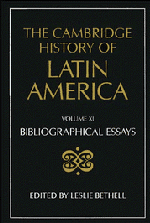Book contents
- Frontmatter
- I THE INDIGENOUS PEOPLES OF MIDDLE AND SOUTH AMERICA ON THE EVE OF THE CONQUEST
- II COLONIAL SPANISH AMERICA
- III COLONIAL BRAZIL
- IV THE INDEPENDENCE OF LATIN AMERICA
- V LATIN AMERICA: ECONOMY, SOCIETY, POLITICS, c. 1820 TO c. 1870
- VI LATIN AMERICA: ECONOMY, SOCIETY, POLITICS, c. 1870 to 1930
- VII LATIN AMERICA: ECONOMY, SOCIETY, POLITICS, 1930 to c. 1990
- VIII IDEAS IN LATIN AMERICA SINCE INDEPENDENCE
- 1 Political and social ideas, 1830–1930
- 2 The multiverse of Latin American identity, c. 1920–c. 1970
- 3 Economic ideas and ideologies since 1930
- 4 Science in twentieth-century Latin America
- IX LATIN AMERICAN CULTURE SINCE INDEPENDENCE
- X THE INTERNATIONAL RELATIONS OF LATIN AMERICA SINCE INDEPENDENCE
- THE CAMBRIDGE HISTORY OF LATIN AMERICA
4 - Science in twentieth-century Latin America
from VIII - IDEAS IN LATIN AMERICA SINCE INDEPENDENCE
Published online by Cambridge University Press: 28 March 2008
- Frontmatter
- I THE INDIGENOUS PEOPLES OF MIDDLE AND SOUTH AMERICA ON THE EVE OF THE CONQUEST
- II COLONIAL SPANISH AMERICA
- III COLONIAL BRAZIL
- IV THE INDEPENDENCE OF LATIN AMERICA
- V LATIN AMERICA: ECONOMY, SOCIETY, POLITICS, c. 1820 TO c. 1870
- VI LATIN AMERICA: ECONOMY, SOCIETY, POLITICS, c. 1870 to 1930
- VII LATIN AMERICA: ECONOMY, SOCIETY, POLITICS, 1930 to c. 1990
- VIII IDEAS IN LATIN AMERICA SINCE INDEPENDENCE
- 1 Political and social ideas, 1830–1930
- 2 The multiverse of Latin American identity, c. 1920–c. 1970
- 3 Economic ideas and ideologies since 1930
- 4 Science in twentieth-century Latin America
- IX LATIN AMERICAN CULTURE SINCE INDEPENDENCE
- X THE INTERNATIONAL RELATIONS OF LATIN AMERICA SINCE INDEPENDENCE
- THE CAMBRIDGE HISTORY OF LATIN AMERICA
Summary
To synthesize the history of science in twentieth-century Latin America is to explore a largely uncharted territory. The first great generation of Latin American historians of science, whose representative figures were Juan B. Lastres in Peru, Alfredo Bateman, Enrique Pérez Arbeláez and Guillermo Hernández de Alba in Colombia, and Enrique Beltrán and Germán Somolinos in Mexico, worked preeminently on the science of the Enlightenment, when scientific activity in Latin America reached a level of brilliance still unsurpassed. Another group of historians domiciled mainly in Argentina (Aldo Mieli, Cortés Plá, José Babini and Desiderio Papp) wrote on mainstream European science, although Babini provided a useful synthesis of science in Argentina, Historia de la ciencia en la Argentina (1949; Buenos Aires, 1986) The 1986 edition includes a perceptive historiographical introduction by Marcelo Montserrat.
Beside’s Babini’s primer, there are few other single-country histories of science. Of these, by far the most analytical is Simon Schwartzman, Formação da comunidade científica no Brasil (São Paulo, 1979), Eng. trans. A Space for Science: The Development of the Scientific Community in Brazil (University Park, Pa., 1991). Although the entire twentieth century is covered, the book’s strength is its description of the prise de conscience by Brazilian scientists of the 1930s through the 1950s, based on interviews with 69 scientific leaders; their biographies are given in a companion volume, História da ciência no Brasil: Acervo de depoimentos (Rio de Janeiro, 1984). Marcos Cueto’s study of high-altitude physiology in Peru, Excelencia científica en la periferia: Actividades científicas e investigación biomédica en el Perú, 1890–1950 (Lima, 1989), is also a study of a nascent scientific elite.
- Type
- Chapter
- Information
- The Cambridge History of Latin America , pp. 878 - 886Publisher: Cambridge University PressPrint publication year: 1995



